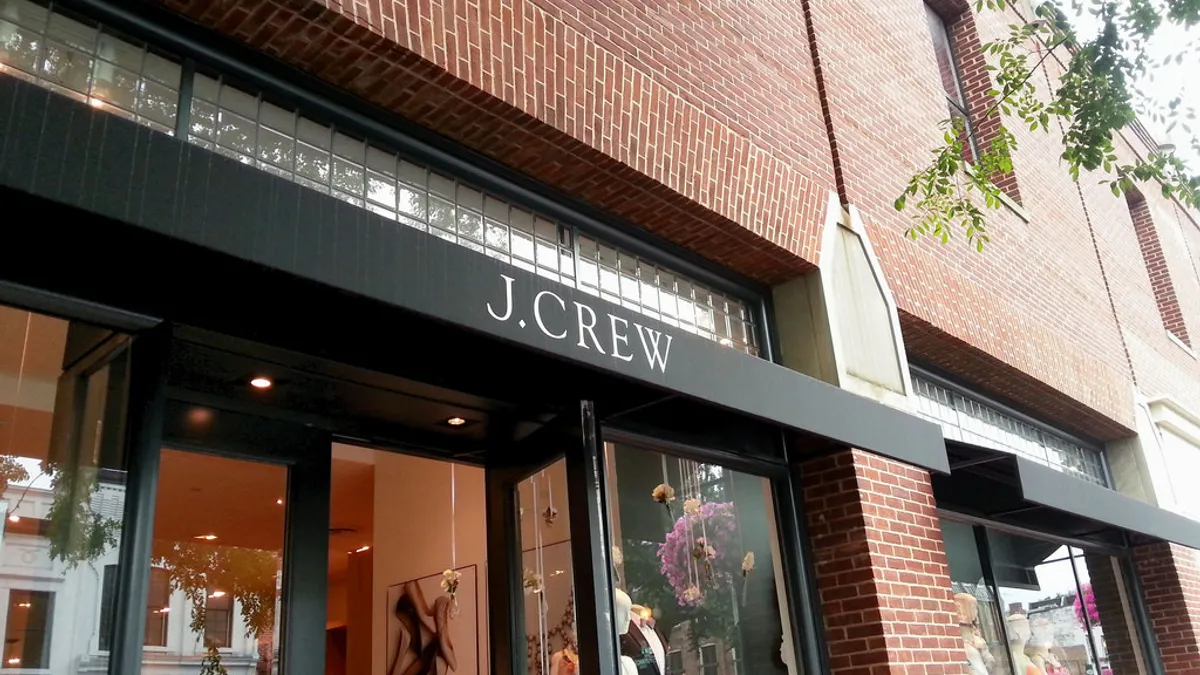Dive Brief:
-
J.Crew Group, Inc. on Wednesday reported lenders holding some 88% of the outstanding principal amount of loans under its amended term loan agreement, first announced June 12, plan to push off at least some of its $566.5 million debt maturity from 2019 to 2021, according to a press release.
-
The amendment is a debt swap of 7.75%/8.50% senior pay-in-kind notes due in 2019 for an equity stake and bonds that mature in 2021. “Addressing the nearest-term maturity removes an overhang in a challenging market environment and provides the company a clear and more confident path to execute its business plan,” the company said in a statement.
-
When first announced, the plan included a proposal for the company's term-loan lenders to dismiss, with prejudice, litigation relating to the assignment of its intellectual property rights, which J. Crew late last year attempted to shield by transferring them to an unrestricted Cayman Islands subsidiary. The term loan amendment wasn't contingent on such an agreement. The Wednesday press release didn't address that aspect of the proposal, and a request for clarification from J. Crew wasn't immediately returned to Retail Dive.
Dive Insight:
J. Crew's massive $2 billion debt load has hampered its ability to stage a comeback, according to Howard Davidowitz, chairman of New York City-based retail consulting and investment banking firm Davidowitz & Associates Inc. "For J. Crew, in my opinion, it’s over, because there is no way to deal with the debt," Davidowitz told Retail Dive. "It’s impossible.”
While the company’s move to back up its restructuring with its brand equity demonstrates its value (the reason the company was so keen to protect that from its lenders, who then cried foul in court), he said its challenged financial position has also meant unfavorable terms from worried suppliers.
“If this were a normal company, with cash in the bank, I 100% believe that three years from now J. Crew would be rolling," Davidowitz said. "But what supplier is going to deal with him in a normal way? Private equity, the first thing they do is put you on the edge. And when you’re an apparel chain, living on the edge is deadly because you can’t fix a business in two years. They borrow billions, they have 80,000 lawyers and now they’re trying — although the court will decide this — to extract from the lenders the only value that will be there, which is the intellectual property of J. Crew and Madewell."
Moody's Investors Service deemed the debt swap plan credit-positive, but said that delaying the maturity debt will only go so far. "The debt exchange will be credit positive because it provides J.Crew with runway through 2021 to execute on its operational turnaround, and lowers its debt load," Raya Sokolyanska, VP-senior analyst at Moody's and lead analyst for J.Crew, said in an email earlier this month. "However, it will still leave the company with unsustainable leverage and uncertain prospects for earnings growth. It will also result in the majority of free cash flow being used for licensing fees, which will pay for cash interest on the new notes."
When it first announced the debt plan, J. Crew also said first quarter revenues fell 6% to $532 million as same-store sales plunged 9%, worse than its 7% decline in the same period a year ago. Operating loss in the quarter was $153.3 million compared with operating income of $7.3 million in Q1 last year. Days before, the struggling apparel retailer had announced that CEO Mickey Drexler will step down next month.
J. Crew isn’t necessarily kaput, despite its sales struggles, its high debts and the high cost of those debts, GlobalData Retail Managing Director Neil Saunders argues, but it's in a "parlous" state. "It is ... desperately struggling and now needs a team that can rekindle many of the things that once underpinned its success," he said. "With losses mounting, this is a task that needs to be tackled with the utmost urgency.”
The effects of changes presumably coming from Lyons replacement Somsack Sikhounmuong and Drexler replacement James Brett, however, “may stimulate fresh thinking,” Saunders said, but in the short-term, are “more likely to prove disruptive than helpful.”
“There is always an argument for change, but change by itself is neither a strategy nor a solution — it needs to be accompanied by a blueprint for reinventing the business,” he said.













